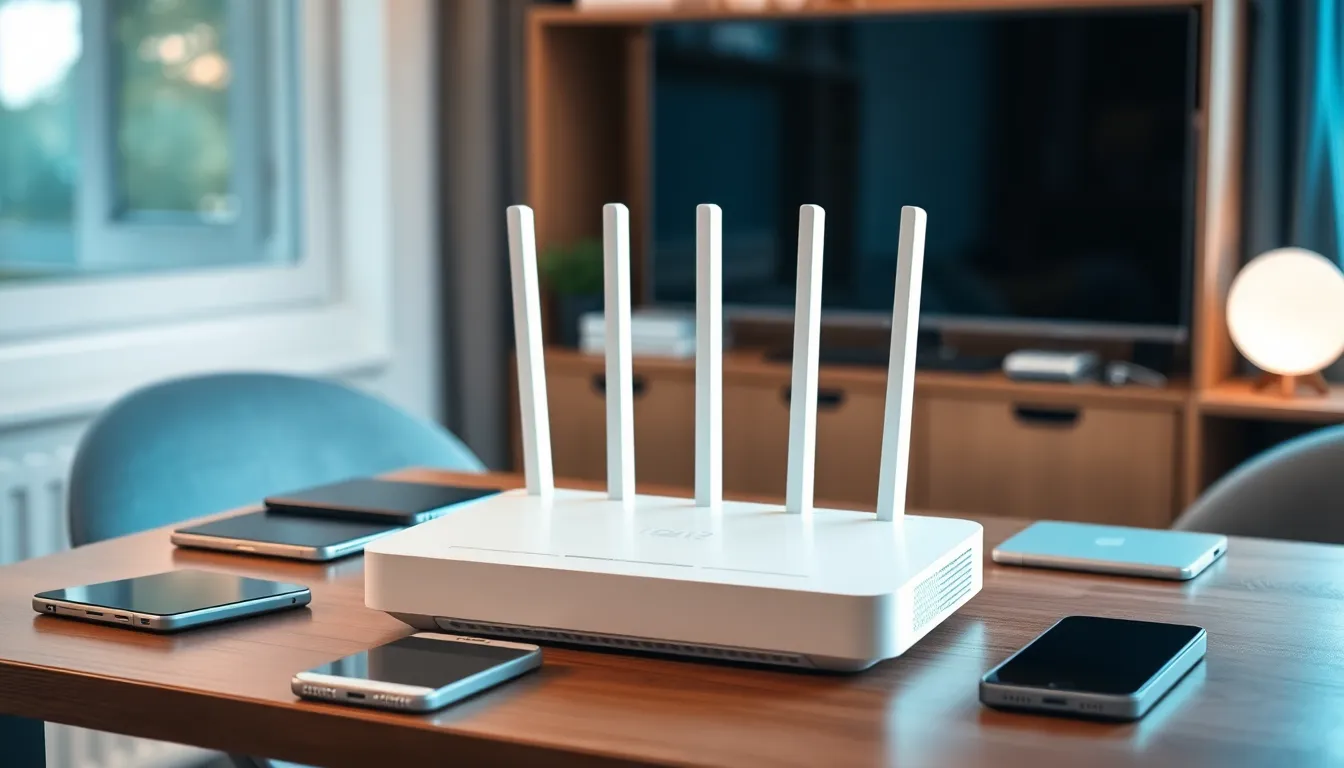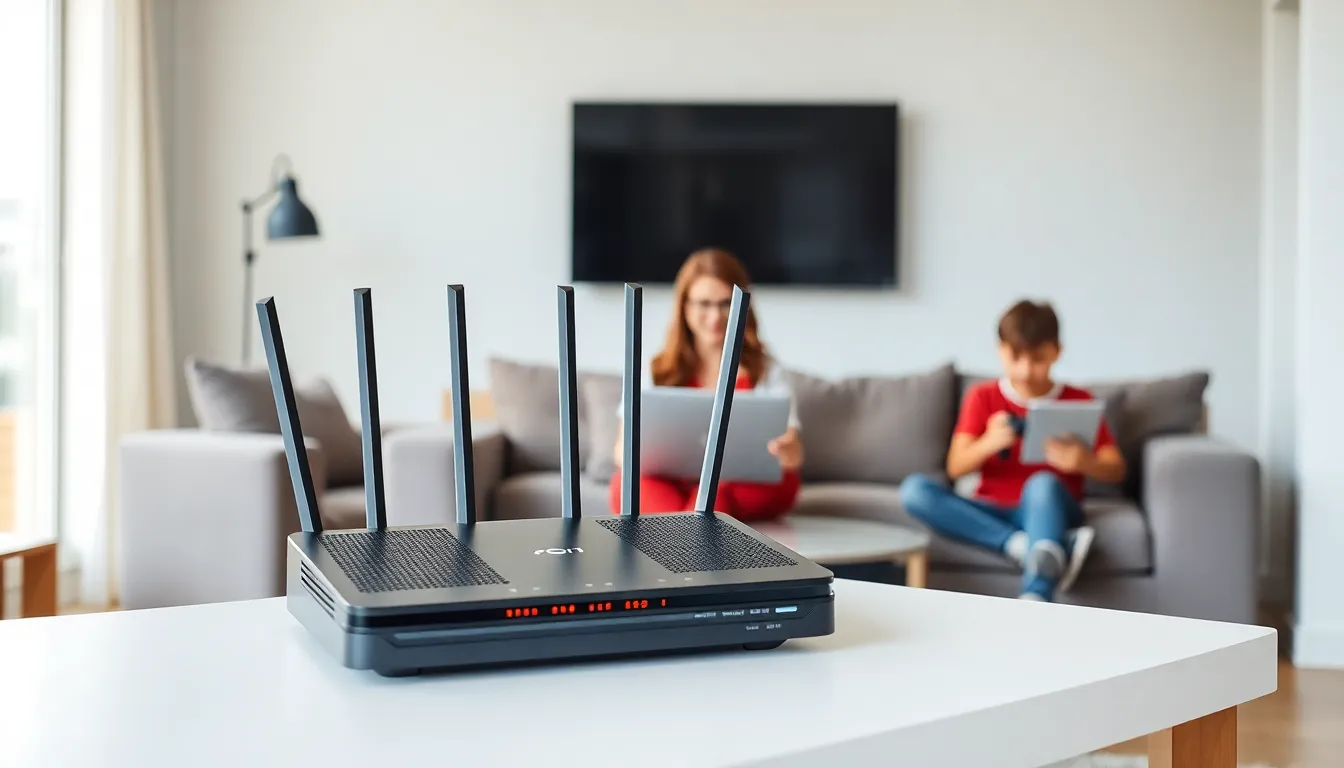In a world where buffering feels like a cruel form of torture, tri-band routers swoop in like superheroes to save the day. These technological marvels offer not just one or two but three bands of Wi-Fi goodness, ensuring every device in the house gets the speed it deserves. Imagine streaming your favorite show while someone else is gaming and another is video chatting—without a hiccup.
Tri-band routers are the unsung heroes of home connectivity, expertly juggling multiple devices and heavy internet usage like a circus performer with flaming torches. If you’ve ever experienced the frustration of slow speeds during peak hours, it’s time to consider upgrading. With a tri-band router, you’re not just getting faster internet; you’re investing in a smoother, more enjoyable online experience for everyone in your home.
Table of Contents
ToggleWhat Is a Tri-Band Router?
A tri-band router includes three distinct frequency bands for Wi-Fi connectivity. It typically operates on one 2.4 GHz band and two 5 GHz bands. Many households benefit from this configuration, especially those with numerous devices requiring bandwidth.
Tri-band routers effectively reduce network congestion. When multiple devices connect, they can spread the load across different bands, minimizing the risk of slow speeds. Streaming high-definition content and engaging in online gaming occurs seamlessly, even during peak usage.
Additionally, tri-band routers support advanced technologies like MU-MIMO. This feature allows simultaneous data transmission to multiple devices, enhancing performance. They often include beamforming technology, directing Wi-Fi signals to specific devices for stronger, more reliable connections.
Many users experience significant improvements in their online activities after switching to tri-band routers. Increased speeds and stable connections contribute to better overall home experiences. With enhanced connectivity options, these routers accommodate modern smart homes effectively.
Users considering an upgrade find that tri-band routers suit households with high device density. They can handle multiple video streams, online gaming sessions, and video conferencing calls without interruptions. The extra bandwidth proves valuable in busy environments where connectivity demands are high.
Advantages of Tri-Band Routers

Tri-band routers provide enhanced connectivity for households with multiple devices. They maximize speed and efficiency, making online activities smooth and uninterrupted.
Increased Speed
Increased speed defines tri-band routers’ effectiveness. This technology offers one 2.4 GHz band and two 5 GHz bands, enabling faster data transmission. Reducing network congestion allows users to enjoy activities like streaming and gaming without lag. Households often see significant gains in performance, especially during peak usage times. Devices connect to the most appropriate band based on their requirements. Bandwidth allocation becomes more efficient, supporting simultaneous connections. Users frequently experience trouble-free browsing and seamless video conferencing.
Better Network Management
Better network management distinguishes tri-band routers from dual-band counterparts. Advanced features like MU-MIMO facilitate simultaneous data transmission to multiple devices. Priority for bandwidth allocation ensures that devices demanding higher connectivity receive necessary resources. Beamforming directs signals towards specific devices, enhancing overall performance. This technology allows for tailored connection quality, resulting in reduced dead zones across homes. Effective management capabilities lead to stable connections, even in busy environments. Optimized performance makes multitasking easier for users, regardless of the number of connected devices.
Key Features to Consider
When choosing a tri-band router, several key features warrant attention. Understanding these features ensures optimal performance and connectivity.
Frequency Bands
Frequency bands play a significant role in a tri-band router’s functionality. Most tri-band routers utilize one 2.4 GHz band and two 5 GHz bands. This configuration allows multiple devices to connect without interference. Users benefit from the better distribution of network traffic. Additional 5 GHz bands enhance wireless speeds for devices demanding high bandwidth like gaming consoles and streaming devices.
Coverage Area
Coverage area is critical for effective home networking. Tri-band routers typically offer broader coverage compared to dual-band counterparts. They incorporate advanced technologies for signal penetration and range. Strategic placement of antennas leads to fewer dead zones within a home. Many models also include mesh networking capabilities, extending Wi-Fi coverage to larger spaces effortlessly.
Device Compatibility
Device compatibility determines how well a tri-band router integrates with various devices. Most modern routers support Wi-Fi 5 and Wi-Fi 6 standards, ensuring compatibility with the latest gadgets. Legacy devices also connect smoothly, making these routers versatile across diverse home networks. Concurrent connections to multiple devices prove more manageable, supporting numerous smart home products without compromising performance.
Top Tri-Band Routers on the Market
Tri-band routers offer exceptional performance for busy households. Popular models include those from well-established brands known for their quality and innovative features.
Product A Review
The NETGEAR Nighthawk RAX200 stands out with its robust performance. This tri-band router features one 2.4 GHz band and two 5 GHz bands, providing speeds up to 10.8 Gbps. Users appreciate the advanced MU-MIMO technology, allowing multiple devices to download data simultaneously without lag. It supports up to 30 devices, making it ideal for smart homes with numerous gadgets. Moreover, the RAX200 includes optimal security protocols, ensuring safe browsing for all users.
Product B Review
The ASUS ROG Rapture GT-AX11000 excels in gaming scenarios. Boasting one 2.4 GHz band and two 5 GHz bands, speeds reach 10 Gbps. Gamers often praise its dedicated gaming features, including a game accelerator that prioritizes gaming traffic. The router accommodates up to 50 devices, perfect for households with high device density. Additionally, it incorporates AiMesh technology, allowing users to create a mesh network for improved coverage throughout the home.
Tri-band routers represent a significant advancement in home networking technology. By providing multiple frequency bands they effectively manage heavy internet traffic while enhancing connectivity for numerous devices. This results in smoother streaming gaming and video calls even during peak usage times.
With features like MU-MIMO and beamforming users can expect improved performance and coverage throughout their homes. Upgrading to a tri-band router not only boosts speed but also offers better network management tailored to modern smart homes. For anyone looking to elevate their online experience investing in a tri-band router is a smart choice that pays off in convenience and efficiency.





